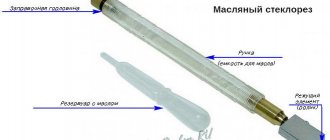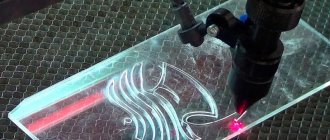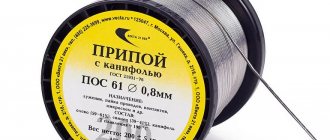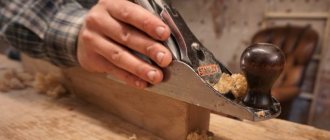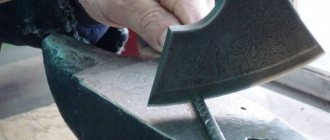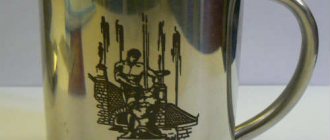Types of glass and features of work
Cutting ordinary glass does not pose any difficulties. Not only glass cutters, but also ordinary tailor’s scissors do an excellent job with this task. But what should those who have set themselves the task of obtaining a glass product with a more complex configuration do? To do this, it is worth familiarizing yourself with the properties of some glasses.
- Tempered glass products . In fact, it is impossible to cut tempered glass at home - it loses its properties. If you want to purchase an item with elements of this material, it is worth considering cutting it in the early stages. In addition, work with it must be carried out by professionals, since the hardening process of the resulting product can only be carried out under certain conditions.
- Fluted glass . This patterned glass is especially popular in glazing doors or creating decorative interior elements. Unlike tempered glass, you can cut such glass yourself. Working with it is not much different from working with ordinary glass, the only difference is that the cut is made from the smooth side. A roller glass cutter is best suited for this.
- Acrylic or organic glass is a transparent plastic created on the basis of synthetic resins. No special tools are required to cut it. At home, a metal saw, cutter and other tools used for edge processing do an excellent job of this task. In addition, a regular stationery knife can handle glass whose thickness does not exceed 2 mm.
In any case, it is worth remembering that working with any glass must be accompanied by compliance with certain precautions. The presence of thick gloves and safety glasses are the main conditions for ensuring your own safety. It will not be superfluous to take care of the arrangement of the workplace. Since working with glass involves the presence of fragments, cover the work surface with any material that you won’t mind getting rid of. Feeling safe will allow you to achieve the best results.
Glass surface processing methods
Manual glass processing requires the use of special techniques and technologies. Most often, a special tool is used for processing glass and precisely selected modes; overheating or uneven load leads to cracking and destruction of the material.
For home use, glass processing is limited to a few techniques:
- Cutting sheet glass into straight pieces;
- Drilling holes and engraving reliefs in sheet material;
- Matting and sandblasting of glass;
- Glass edge processing;
- Polishing glass surface.
For your information! In addition to mechanical polishing, chemical polishing, grinding and engraving are also used. But the use of such methods requires the use of toxic and dangerous reagents, so it is practically not used for household work.
Manual glass cutting
At home, cutting and grinding of edges are usually used. More complex techniques are not used for two reasons. Firstly, to obtain a high-quality surface, special equipment and glass processing machines are required, and secondly, during mechanical peeling, grinding and drilling, a large amount of tiny glass dust is formed, which is extremely harmful to health.
Cutting sheet glass using a diamond or carbide roller is performed for material with a thickness of no more than 6 mm. Thicker sheets are cut using special devices and machines.
Cutting a glass sheet using a hand diamond is performed in the following sequence:
- The glass is laid out on a flat, clean surface, usually covered with soft wrapping paper used to collect glass shards. The sheet should fit as closely as possible to the lining material;
- A steel ruler is applied to the cutting line and carefully, with minimal pressure, drawn with a diamond tip in one movement, without lifting the tool or stopping its movement;
- The glass is lifted and the cut line is carefully tapped on the back side with a rubber or wooden hammer. When you tap along the line, a large number of microscopic cracks are formed, greatly weakening the strength of the material, and as a result, the glass breaks exactly along the trajectory of the diamond.
For your information! When cutting thick sheets, do not use carbide rollers or tips; such a tool produces a large amount of waste.
At the same time, with a diamond glass cutter placed on a ballerina, you can easily cut out arcs, circles and even round holes in the glass.
Manual glass grinding
The cut fragments, as a rule, have sharp edges and edges that can easily injure your hand or fingers. Therefore, it is necessary to process the edges of the glass using a machine or smoothing on edge wheels. Most often, the device for wiping edges is a low-speed motor with a special abrasive wheel or a wooden block onto which fine sandpaper is glued.
Treatment is carried out with periodic wetting of the edges with water and abrasive paste. The result is a smooth, slightly rough surface. If you use diamond paste or a glass edge processing machine instead of an abrasive paste, you can achieve absolutely smooth edges. In a similar way, glass and mirrors are processed using high-speed precision rollers and a diamond suspension on polishing equipment.
Before cutting glass
The main knowledge of a glazier is knowing how to cut glass correctly, so that the required size and shape is obtained, as well as so that the edges are smooth and without chips.
Previously, both glass and the tools for processing it were expensive and only craftsmen with good skills were engaged in cutting glass, but in our time the situation has changed significantly. Nowadays, anyone can work with glass.
Tool
To work with glass, you need a very good tool.
That’s why, before you buy glass and work with it, you need to start shopping with the tool.
But you shouldn’t buy the first tool you come across, because it may be of poor quality and will not be able to cut the glass as needed.
It is very important to determine what tool you need, because there are several types of glass cutters:
- Roller;
- Diamond;
- Oily;
Roller
The roller glass cutter for cutting glass has a built-in special roller, which is made of a very durable tungsten-cobalt alloy. The usual roller diameter is 6.6 mm, this roller diameter allows cutting glass up to 4 mm thick.
Diamond
The diamond glass cutter is equipped with a correspondingly small diamond, this diamond cuts glass. The hardness of diamond is well known and therefore it has long been used for cutting glass.
Nowadays, as before, a diamond glass cutter is considered the best tool for cutting glass.
Oily
Not long ago, an oil glass cutter was added to the list of glass cutters.
This is essentially an improved roller tool that has a reservoir built into the handle to supply lubricant to the roller. This lubricant binds particles that were formed when cutting glass while ensuring smooth movement. This glass cutter can cut glass up to 20 mm.
Workplace
Glass does not withstand local lateral loads well. The pressure from the glass cutter is what causes them. Therefore, a home craftsman should work with glass only on a prepared, clean and level surface.
A coating made from a solid sheet of fiberboard and similar materials is well suited. It is perfectly acceptable to cover a regular table with a blanket and cut on it.
Features of glass cutting technology
Before cutting glass, it is necessary to properly prepare the material. The glass should be washed from dust and thoroughly wiped with a dry cloth. If there is debris in the path of the cutting tool, the cutting angle may change, which will not only lead to defects, but may also damage the tool. The debris can be completely unnoticeable particles of glass chips or fragments. Even ordinary dust can significantly affect the quality of the cut.
The flat surface to be processed should be level and without slopes. In addition to the glass cutter, you need to prepare a marker and a thick ruler to mark the cutting line.
When using a diamond glass cutter, no special effort is required. The tool must be pressed with approximately the same force as a pencil. It can be difficult for beginners to set the correct direction to the cutting element and select the appropriate angle of inclination. To understand the principle of operation, you can practice first on a sheet of rough material. After making a thin linear cut, you need to remember what position the glass cutter was in, and use the same principle to do it on a normal sheet. To make the cut easier, you need to move the tool evenly along the length of the ruler without changing the pressure on the tool or the angle of inclination.
Roller glass cutters must be held perpendicular to the plane of the material. Along the edges of the sheet, small linear markings are made with a glass cutter, thanks to which the pressure on these fragile parts can be eased. Otherwise it will lead to chipping. After this, you need to step back with a ruler from the markings to the width of the cutting element and make the cut. The work must be done from the far edges; the glass cutter should be brought towards you, pressing its side tightly against the ruler.
The cut must be done quickly. Thus, it takes about 2 seconds to travel 1 m. When working with a roller glass cutter, it is necessary to apply more force than when working with diamond tools, and the pressure should not be changed along the entire length, except for the edges.
How correctly the instrument is used can be determined by hearing. If there is a steady hissing or crackling sound, we can say that the work is being done correctly, but if squeaks or squeaks occur, this indicates that something is being done incorrectly. This indicates that the tool is dull or the pressure is too weak. The presence of small white fragments on the line may indicate overdoing the pressure, so it should be slightly loosened.
A high-quality cut will make it possible to easily break the glass and obtain smooth edges.
Defective lines or glass that is too thick will need to be tapped on the other side of the sheet. To do this, you need to move the glass to the edge of the working surface so that the linear cut is 5 mm from its edge. Then, using the head of the tool, you need to tap along a line from the top edge of the sheet to the bottom. Due to this, microcracks are formed, which make it easy to break off the material being cut. You can use the side of a glass cutter or pliers to break off small strips of glass.
How to cut glass
A sheet of glass is not as easy to cut as it seems at first. To make a glass cut, preparation is necessary.
Preparation
- Absolutely new glass will only need to be thoroughly cleaned of dust and wiped dry with newspaper; fabric is not suitable for such work.
- If you have to cut old glass, you should first degrease it, after which the glass is washed well with water and detergents.
- After all the above manipulations, the glass will need to be dried in a closed and clean room.
Cut glass
Preparatory work also includes cutting glass and preparing containers for waste collection. There should be two containers, that is, for collecting small waste and for collecting larger ones, which may be useful for something in the future.
When cutting glass, it is best to start with simple window glass and then move on to more complex options.
How to properly scratch
When cutting a groove, loads are created that work to shear the surface layer.
They cause deformations that form microscopic surface, lateral and deep cracks.
The correct cut is ensured only by those microcracks that are directed into the depth of the material - the middle ones. All others are not needed. They must be avoided.
The cutting quality is affected by:
- cutter sharpening angle;
- roller diameter;
- pressure on glass;
- position of the cutting organ.
Glass cutting technique
- First you need to prepare a table or other surface for cutting glass. The surface is covered with four or five layers of newspaper; this procedure is necessary to protect the table from glass chips. This will also distribute the pressure of the glass onto the table surface, preventing the glass from cracking.
- The glass sheet is placed on the table, and it is necessary to retreat five or seven centimeters from the edge of the tabletop. In order to fix the body and at the same time move the body freely above the cut site, it is best to place your feet shoulder-width apart. This body position allows you to achieve good results.
- When cutting glass, it is best to hold the blade with your free hand to avoid vibration. But keep in mind that glass is a fragile material and with more pressure it can crack.
- Use a glass cutter to draw a line from one edge to the other. In this case, the glass cutter wheel must be guided clearly along the marked line and the glass cutter must also be at a right angle.
When using a diamond glass cutter , you need to hold it at the very bottom of the handle and smoothly draw a line along the ruler, almost without pressing on the glass.
When cutting glass with a roller glass cutter, slight pressure is required and when the glass cutter moves, a whitish stripe appears on the glass surface, deeper than when using a diamond tool.
How does the roller sharpening angle affect the cut?
As an example, let’s look at the designs of three cutters designed to work on industrial glass cutters of automatic robots.
The direction of the forces pushing the surface layer apart when creating a scratch is always perpendicular to the pressing plane. A sharper roller deflects the acting force more widely from the normal to the surface, creating a smaller area of stress penetration.
To cut thick glass, use a tool with a wider sharpening angle, and for thin materials, use sharp ones.
On factory models of glass cutters, the sharpening angle is already created to work with standard glass used for domestic purposes.
How does the roller diameter affect the cut?
Smaller dimensions allow better scratching of the outer surface of the workpiece. However, the designs of the glass cutter have already been adjusted at the factory to optimal performance, and the home craftsman will not be able to change anything here.
The tool is purchased ready-made with standard roller diameters. As they lose their sharpness, which rarely occurs in everyday life, the dull part is simply replaced with a backup one.
How does pressure on the roller affect the cut?
The depth of penetration of a scratch into the glass depends on the applied cutting force. When choosing a sharper cutter for thin material, you should take into account that it is dangerous to create a high load with it, because you can simply crush the material.
To make it easier to cut the workpiece when performing such work, always ensure that the glass is clean and treat its surface with special liquids that:
- lubricate the roller;
- provide a hydraulic cushion;
- reduce the effect of the Rebinder effect, reducing the strength of the outer surface;
- wedge the material.
At home, you can easily get by with kerosene for these purposes. It is convenient to apply it manually with a piece of rag or use a specially designed glass cutter.
How does the roller position affect the cut?
The picture with the sharpening angles of the cutter makes it clear that the roller must be guided strictly perpendicular to the glass surface.
Its deviation from the normal will lead to lateral displacement of the median crack and incorrect chipping.
About the number of cuts
There is a misconception among beginners that one scratch is not enough and that several repetitions must be done. They say they will deepen the crack. So such masters use a glass cutter several times in the same place.
This is a gross mistake: with each movement, repeated deformations of the material and additional cracks are created in all directions. They reduce the overall strength of the workpiece and can lead to improper fracture during bending.
Possible mistakes
When there is a river of glass, there are two mistakes:
- The pressure with a glass cutter can be too strong;
- The glass cutter is carried out several times in the same place.
How to cut, grind and drill glass
To cut glass you need a good quality glass cutter. Professionals work with glass cutters equipped with
diamond stone. The cost of such a tool ranges from 150 to 800 UAH. When choosing a glass cutter, you need to be guided by a simple rule - the thicker the glass, the larger the diamond stone should be. Natural stone is preferable to artificial stone and can handle thicker glass.
To make a glass cutter last longer, you need to follow a few simple rules.
- There is no need to touch the diamond to any other objects. The stone should only be in contact with the object being cut.
Before cutting, the glass must be cleaned of dirt, washed and wiped dry.
- When the stone on one side becomes dull, it can be turned over to the other side. And on roller glass cutters you will have to change the working roller.
Glass cutting
Glass cutting work must be performed with gloves and safety glasses.
The procedure for cutting glass is as follows.
We clean the glass from dust, dirt, grease;
lay the glass on a flat horizontal surface;
We take a thick ruler and apply it to the marking, holding it firmly in one place. To prevent the ruler from moving on the glass, you can stick a rubber strip on its back surface.
Important. There is no need to press hard on the glass cutter, otherwise your hand may tremble. The main thing is to draw the line without lifting the stone from the material, with uniform, moderate force.
Now you need to separate the parts of the stele along the applied groove. It is better to first tap the glass from the back side along the cut line with a hammer. This line is then aligned with the edge of the table, and the overhanging part of the glass is pressed with a quick movement of the hand. As a result, there should be an even break along the furrow, and the hanging part should remain in the hands.
If the break turns out to be flawed, then its edges are trimmed by breaking off pieces of glass with pliers or a device on a glass cutter.
A figured neckline is, of course, much more difficult to perform. You will have to do without a ruler, and work with a glass cutter along a previously drawn line “by hand.”
After cutting, the edges of the glass are polished, removing sharp edges and irregularities and giving the edges strength and aesthetic appearance.
Grinding the edges
After cutting glass, its edges remain uneven, with sharp, jagged jagged edges. At the same time, the glass does not have the proper appearance, often needs to be adjusted in size, its edges are not strong and can crumble. Therefore, after cutting or drilling, the edges of the glass are ground, bringing them to a smooth state.
This work can most easily be done with high-speed power tools equipped with special diamond-embedded grinding wheels. The grain size is indicated on grinding wheels as a number, for example - C20. This circle is classified as medium-grained. The size classification is as follows:
- 25 – 40, - large grain;
16 – 25, – average;
It will be better if you use several wheels with different grain sizes. Then the edges of the glass can be brought to an even, smooth state without the use of fine sandpaper or manual work. For finishing, use a fine-grained wheel, for example C5.
There are also special grinding machines that operate using coolant.
Sanding can also be done manually without the use of power tools. But this is a very labor-intensive process. The work is done using waterproof sandpaper. First use coarse sandpaper, and then fine sandpaper. During this process, the surface of the glass is wetted with water.
How to drill
For drilling glass, special hard drills in the form of a feather are used. The cost of such a drill can range from 10 to 150 UAH, and the working edge is made of either very hard steel or diamond stone.
Drilling glass is performed in the following order.
- The glass is prepared, cleaned of dirt, washed and wiped dry.
Then the material is laid on a flat and durable base, preferably made of wood or chipboard.
The drilling location is marked on the glass.
There are special wetting liquids for sale for this process, for example RD-R070. They are used to improve heat dissipation from the cutting point and to facilitate the entire process. It must be borne in mind that without the use of cooling, the glass may overheat and crack. But if you don’t have a special liquid, it doesn’t matter; you can get by with plain water. To prevent liquid from spilling, it is useful to make a dam of plasticine around the hole.
Also, in order not to overheat the glass, you can use the technique of turning the material over. Having drilled halfway, you can turn the glass over and drill from the back side, this is especially necessary when drilling thick glass.
To obtain large diameter holes, you will have to use a glass cutter. First, draw the required circle on the glass with a marker. Using a drill with a feather drill, drill a small hole in the center of the circle. Then we tie the glass cutter with a cord of the required length, the end of which is secured in this hole. Carefully and slowly, holding the glass cutter in a strictly vertical position, cut a groove on the glass along the marked line. Using a glass cutter and a ruler, we draw several grooves from the central hole to the circle using a glass cutter and a ruler. Now all that remains is to carefully break the segments of this circle with light blows of a hammer so that they fall out of the glass. After finishing, the edges of the resulting hole are ground and brought to a smooth state.
How to cut glass at home without a glass cutter
Twine, gasoline and lighter
The method described below will tell you how to cut glass evenly if you don’t have a glass cutter at hand. Everyone knows that the material is afraid of sudden temperature changes. This property can be used to cut it. For work you will need: twine with a maximum thickness of 2 mm (cotton only), lighter, gasoline (kerosene).
The glass sheet is placed on the table and a line along which it needs to be cut is marked with a marker. Measure and cut the twine so that it covers the entire length of the cut. After that, it is poured with gasoline and applied to the line on the glass. The twine must be set on fire so that it lights up along its entire length. When the thread goes out, water it with cold water. As a result, the glass will crack at the location of the temperature difference. If the crack does not extend across the entire sheet, then you need to repeat the procedure and lightly tap along the cut line.
Soldering iron
A straight cut is not always needed, and in this situation a file and soldering iron will help out. If you don’t have a soldering iron, a wood burning device will do.
The process is long but creative. First, mark the glass and use a marker to draw a cutting line on it. Then, at the edge, at the beginning of the mark, using a file, make a groove, which will serve as a guide. Having retreated a couple of millimeters along the line, use a soldering iron to heat the glass until a crack appears from the groove to the heating point. Then they retreat another couple of millimeters and repeat the process.
To make things go a little faster, the glass can be cooled with a damp cloth or dishwashing sponge.
File
For the first method, you need a file with corners; a round tool will not work. To cut glass, you should make several even thin strips on it with a tool. You need to press the file a little harder than average, and in the end you will get a clear, shallow strip, as if using a glass cutter. After this, you should simply break the glass on the edge of the table, or do this by placing a match under the cut.
The method is recommended for people who already have the skill to communicate with glass. If this is the first time such work is being done, it is better to try your hand at small pieces of glass in advance.
Scissors
It’s worth mentioning right away that the technique allows you to cut thin glass, no more than four millimeters. When working, it is recommended to wear safety glasses and protect your hands with gloves. You will need a container with water, in which, in fact, everything will happen.
Water acts as a lubricant, allowing you to cut the desired shape using scissors. No matter what tool you come across will not work - you need something serious, like tailor's scissors. Cutting is carried out according to pre-applied markings. The cutting force is comparable to what is needed when working with hardboard.
One more nuance: the container must be deep enough so that the layer of water above the glass immersed in it is large. To what extent it can be verified empirically, you should first experiment with an unnecessary piece of glass.
Charcoal cutting
Below we will talk about how to properly cut glass using a charcoal pencil (you can do it yourself). It allows you to cut various shapes from the material. To make the tool you will need: charcoal (linden, birch) and gum arabic. The coal is ground into powder, gum arabic is added to it and a kind of dough is kneaded. Round sticks are made from the mass, after which they are thoroughly dried.
How is processing done?
One of the stages of work is processing the edge of the glass. Although professional workshops use special machines, at home it is most convenient to use a sharpening stone and a file. There are two types of files:
- Personal.
- Velvet.
A velvet file is used for thin material, and a personal file is used for thick material. When you start working with a file, you need to moisten it with either water or kerosene, or you can use a 10 percent camphor solution, which is based on turpentine.
Sharpening stones are also used in two types:
- Carborundum.
- Emery.
Carborundum bars do not need to be wetted. When working with the edge of a glass sheet, it is not recommended to press on the tool, and movements should be along the edge. You need to remember that special care is needed when the glass is very thin.
A little about the professional machine
You can take a closer look at the glass edger, which is used to grind and polish the edge of sheet material. The equipment includes a special air purification system.
This system consists of three parts, two main filters and one control filter. If the control filter becomes clogged, it becomes clear that the main filters need to be cleaned. This machine also has a specially equipped belt that processes the edge. This equipment also has a special air cushion, which helps the workpiece move smoothly across the table area. Air is supplied through special small holes made in the table. When this function is turned on, the sheet of glass seems to float on the table and moves very easily in different directions.
Processing methods
There are two ways in which glass is processed. For example:
- Decorative cold.
- Chemical.
The first common method is sandblasting glass. It is performed with a special apparatus. Compressed air delivers a jet of sand to the surface of the material being processed.
Cut off. When cutting, hold the glass cutter vertical to the glass, pressing it from above with your index finger. Use a glass cutter to run along a smooth strip or insulating tape. Start from the end. Guide the glass cutter towards you, pressing evenly on the surface. Only do it once. Before breaking off, place matches at the end of the cut. Gently tap the cut with a hammer until it becomes a straight cut.
Take a file, it’s suitable for thin glass, but for personal use it’s better. Place a small jar of kerosene or turpentine to constantly wet the file. You can also use a solution of camphor in turpentine in a ratio of 1 to 10. For sharpening stones, use emery and carborundum stones; By the way, the latter do not need to be wetted.
Start filing the glass along its edge. Work very carefully, especially with thin material. To get a straight edge, move the glass back and forth across the surface of the block. Constantly wet the instrument in the prepared mixture.
For this work, use old sanding blocks and old files, as sanding will cause scratches on the blocks and make the file dull.
You can also take a block of wood and wrap it in sandpaper to get the job done. Use a coarse one first, then change to a finer one. Make sure that when processing the ends you do not touch the surface of the glass itself, otherwise scratches will appear on it.
When processing glass edges, it is imperative to wear cotton gloves, and to protect your eyes, it is better to wear safety glasses.
Processing the edge of glass is a labor-intensive process that requires extreme care and precision from the craftsman. This procedure can be performed either on special equipment in specialized workshops or at home using available tools.
You will need
- - glass cutter;
- - pliers;
- - sandpaper
- — carborundum stone;
- - water.
Instructions
Remember: glass processing can be done in two stages: by grinding the edge of the glass and polishing it. During the grinding process, the edge of the glass remains rough, but at the same time it is leveled and becomes safer. During polishing, the edge acquires a transparent appearance and a smooth surface.
Rough-cut the edge of the glass using pliers or a glass cutter (more precisely, the notch on its side). This procedure is carried out as follows: grab 2-3 mm of the protruding edge of the glass with the tool you are using and, moving up or down, break off the sharp protrusions. If the protrusions are small, they can be “brightened” by pinching and squeezing firmly with pliers.
Finishing is carried out by two methods: straight and curved. Straight-line processing will allow you to obtain profiles of various types: trapezoidal, flat, rounded, as well as shaped
Glass, as one of the most expressive and beautiful materials, has always attracted designers and interior decorators. The glass surface has two serious disadvantages - high fragility and hardness, so processing glass at home is always fraught with significant difficulties. However, the material can be successfully cut, ground, polished and even drilled.
How to make a hole for a handle
There are several options - either drill using a drill with a pobedite nozzle, organizing a bath of plasticine with camphor and turpentine on the surface, or using the thermal method. To do this, apply fine wet river sand to the glass, and using a sharpened rod, make a funnel in it, into which molten solder or lead is dripped. After a couple of minutes, the sand and solder are removed.
Maybe someone will consider the list of methods incomplete - we have a lot of Kulibin methods, and there are many more options for solving the problem. But the advantage of the methods described, and in bold, is that they work.
Possible mistakes
Most often, inexperienced carvers make the following erroneous actions:
- When cutting corrugated glass, they do not use a roller tool, but a different model of glass cutter. In addition, frosted glass with patterns and grooves is not cut from the smooth side;
- The dimensions of the final workpieces are often not respected. Trimming should be done in such a way that the dimensions are a couple of millimeters smaller than the frame into which the glass is planned to be inserted;
- when working with a glass cutter, additional materials are ignored - patterns, which are special rulers;
- It is recommended to ensure that the glass cutter is suitable for use before each cut. To do this, its sharpness is checked - a piece of glass is cut off on already cut pieces. If during cutting you hear an unpleasant creak, the cutting edge needs to be sharpened.
The glass cutter must be checked before each cut.
Compliance with safety regulations
To avoid injury, you should work with gloves. Pay attention to shoes that should be durable so that accidental glass does not cut your feet. It is necessary to dress in thick overalls made of thick fabric.
Sources
- https://vopros-remont.ru/obshhie-voprosy/kak-rezat-steklo-pravilno-uchimsya-rezke-svoimi-rukami/
- https://stroypomochnik.ru/kak-rezat-steklorezom-01/
- https://domsdelat.ru/instrumenty/kak-pravilno-rezat-steklo-v-domashnix-usloviyax.html
- https://HouseDiz.ru/kak-prosto-rezat-steklo-v-domashnix-usloviyax-svoimi-rukami-steklorezom/
- https://FB.ru/article/264894/kak-otrezat-steklo-bez-stekloreza-poshagovaya-instruktsiya-sposobyi-i-rekomendatsii
- https://setafi.com/lajfhaki/kak-bez-stekloreza-razrezat-steklo-v-domashnih-usloviyah/
- https://2lzz.ru/ruchnoj-instrument/steklorez/7-sposobov-kak-bez-stekloreza-razrezat-steklo
- https://izobreteniya.net/kak-razrezat-steklo-bez-stekloreza/
